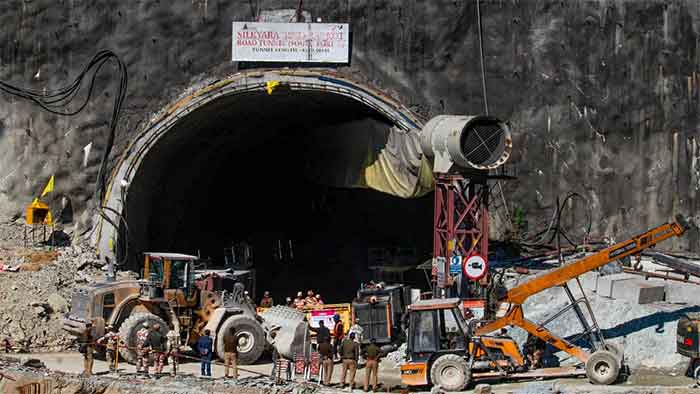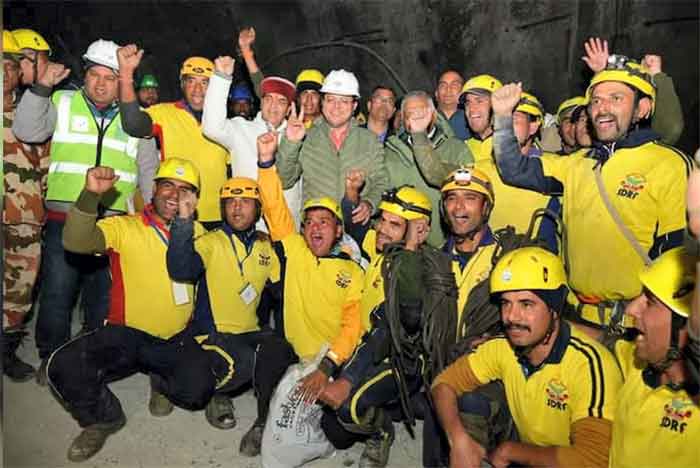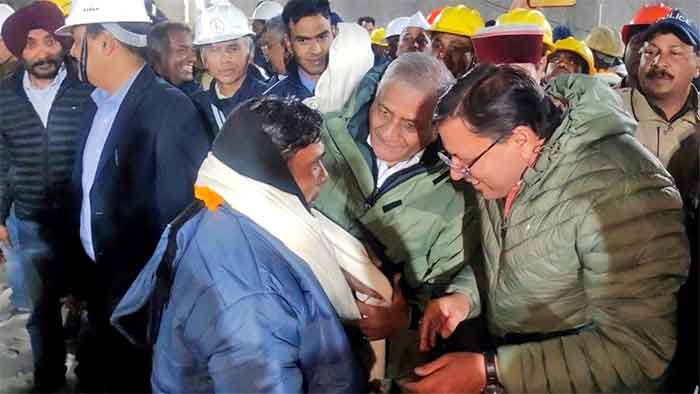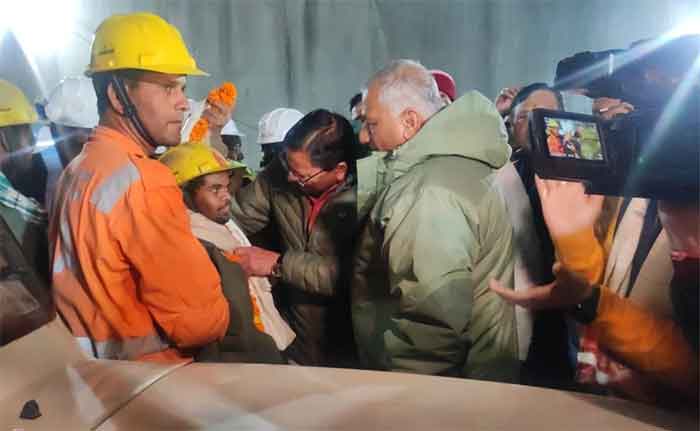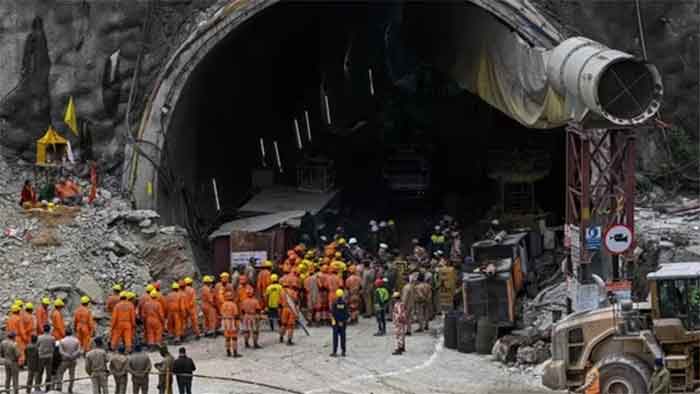
On the day of Diwali when the country ushered in the festival of lights, forty-one of her labouring sons were plunged into darkness as a scenic Himalayan mountain caved in on them. While the earth continued to revolve on its axis, for the hapless workers trapped within the Silkyara under-construction tunnel in Uttarakhand, the agony seemed eternal till the time they were ultimately rescued on the seventeenth day. Story after story on the successful rescue of the forty-one workers, their fortitude and resilience, their jubilant reuniting with family, as well as accounts of the praiseworthy efforts of the ‘rat miners,’ have proliferated the public domain. The present narrative is consumed with showcasing how rat miners–manual excavators performed a task which “even machines failed to do” – a projection that conveniently elides how the rescue operation was the combined outcome of massive machines drilling into the bulk of debris, as well as national and international expertise on tunneling. The miners’ ability to shovel through the last few meters of debris was ultimately possible due to advanced mechanization and technological knowhow. More importantly, we cannot overlook the fact that the much talked of rat-hole mining technique is a primitive and unscientific one which has cost many a life. Notably, it is a form of mining which has been declared illegal in some parts of India like Meghalaya. Hailed as “skilled labourers” by the authorities and the company involved in the Silkyara tunnel construction, it is indeed shocking that the majority of these skilled miners in India are mere daily wagers, and hence, insufficiently covered under the country’s labour laws.
Profits over limbs and lives
Needless to say, the jubilant reports of the rescue at Silkyara will be short-lived, and the workers will soon return to a world of work where millions like them continue to labour daily under voluminous precarity so as to eke out a meagre living. If only we were willing to look beyond the dominant narrative valorizing the feats of human labour in rescuing its own, we would begin to see that the sensationalized news reports are a smokescreen, aimed at concealing the blatant callousness and criminal apathy which prevails with respect to the safety of Indian workers and their otherwise miniscule entitlements.
Part of the Char Dham project, the Silkyara tunnel was being dug in an ecologically fragile and hazardous mountain range. Consequently, any infrastructure project in the region necessitates the use of extra caution. The mountain in which the Silkyara tunnel was being dug contains phyllite, a very weak rock made of clay minerals. Shockingly, according to Dr. Yaspal Sundriyal, Professor of Geology at the Hemwati Nandan Bahuguna Garhwal University, no formal geological and geophysical assessment of the terrain was done prior to digging the tunnel. It was reportedly only after the initial days of failed rescue operations that a geophysical survey of the terrain was undertaken.
Evidently, necessary measures to ensure the safety of workers in such difficult terrain were overlooked by the concerned company and commissioning authority. In a recent interview, Dr. Sundriyal revealed that instead of utilizing tunnel boring machines (TBMs) which disturb only a restricted surface area where a tunnel is under construction, dynamite blasting and JCB machines were used, which clearly unsettled a large area of an already unstable terrain. The provision of emergency exits during tunnel construction – a crucial safety precaution – was also reportedly missing, which further added to the difficulties of the rescue operations. Further, the provision of stability to the excavated portion of an under-construction tunnel at every few meters is essential. This is done by using iron pipes in a horseshoe or arch shape so as to hold up the excavated part together. In this regard, in his interview, Dr. Sundriyal pointed out that in the Silkyara tunnel, mere concrete was thrown on the sidewalls and ceiling by high-pressure machines, which is material less capable of taking the weight of a mountain. This apart, according to him, the workers were made to work in that portion of the tunnel where even the concrete had not been applied. Dr. Sundriyal explained in his interview that RCC (reinforced concrete cement) treatment was completed only up to approximately 200 metres from the Silkyara side, and the tunnel collapsed after 250 metres (from the Silkyara side), trapping the workers of the night shift. An accident of the magnitude we saw was just a matter of making. Perhaps we may get to know the precise reasons for this mishappening only if a proper impartial investigation is carried out and made public.
While there has been a serious problem with the planning and execution of the concerned tunnel project, it is indicative of a larger problem of lax safety and security at workplaces. Almost every day there are incidents involving deaths in gutters and sewers, cave-ins at construction sites and mines, as well as factory accidents that result from violations of safety protocols. Geared towards keeping costs of production low in the bid to stay competitive, most employers compromise on labour safety and improved mechanization of the work process. Scant regard is paid to safety training of workers since they are easily dispensable and disposable. It is ultimately cheaper to send stigmatized human labourers into sewers and septic tanks without any safety gear than to invest in advanced cleaning machines and sewage systems.
Likewise, preoccupied with cost cutting, employers conveniently postpone machine repair and upgradation at the price of the limbs and lives of their workers. Only a few such incidents gain adequate public attention, and sadly, none of the tragedies translate into the reversal of workers’ precarity. Culprits are seldom prosecuted due to lax investigations that culminate in weak chargesheets. In fact, the more stringent sections of the law, such as Section 304 of the Indian Penal Code which pertains to culpable homicide not amounting to murder, are avoided as employers are usually booked under bailable sections, such as 304A for causing death by negligence. Compensations, if awarded, are usually a pithy amount and are difficult for affected workers and their kin to access. It is the same for fines imposed on erring employers and authorities. Note for example that the National Green Tribunal fined the Meghalaya government a mere Rs.100 after the 2018 incident involving the death of fifteen ‘rat miners’ in a mine in Ksan.
Needless to say, fines and bans have yielded little in terms of generalization of model employment practices and adoption of more advanced techniques and technologies in numerous work processes. Lack of gainful employment generation, among other factors, continue to push the bulk of labouring poor into low-paying, unsafe, and often prohibited forms of work. For instance, the much-hailed team of so-called rat miners brought from Delhi to Silkyara comprised workers who are engaged as manual excavators in big cities. They enter constricted spaces to clean and repair water and sewer pipes. Clearly then, even though the contributions of the ‘rat miners’ are commendable, their feats should not be used to downplay the crucial question of the dire need for enhanced mechanization of many tedious and dangerous work processes prevalent across the country. This is more so when we consider the distressing data on reported deaths and injuries of workers at the workplace. In Meghalaya, for instance, despite the ban on rat-hole mining, such mining persists, and so do fatal accidents. Since 2018, at least twenty-eight people have reportedly died while rat-mining.
Coded precarity
Due to corruption and collusion between companies, hospitals and officials, majority of industrial accidents fail to gain public attention, until of course some major incidents taking a significant toll in human life occur. This apart, there are serious structural problems with the existing labour law itself, which tend to institutionally invisibilize majority of industrial accidents. As per information provided by the Directorate General Factory Advice Service & Labour Institutes (DGFASLI), Ministry of Labour & Employment, there are an average of around 1200 deaths and more than 4000 injuries per year in registered factories. Such data is known to exclude more than ninety percent of workplaces, including unregistered factories, and is thus a gross underestimate. Despite a Parliamentary Standing Committee on Finance questioning the Ministry of Statistics and Programme Implementation for repeated delays in the release of the Seventh Economic Census that was launched in 2019 and concluded in March 2021, recent data on the distribution of establishments by size is still not in the public domain. As per India’s last Economic Census conducted from January 2013 to April 2014, less than a million or a mere 1.4 percent of establishments in India employed more than 10 workers. The vast majority of enterprises; namely, 55.86 million establishments (95.50 percent) employed one to five workers, while around 1.83 million establishments (3.13 percent) employed six to nine workers. Against this backdrop of dwarfism or predominance of micro and small enterprises, the threshold limits of the Factories Act, 1948, and the Occupational Safety, Health and Working Conditions (OSH) Code, 2020, tend to simply keep the vast majority of workers outside the ambit of compliance with safety measures.
Typically, the bulk of so-called industrial accidents involve construction workers, sanitation workers, and the continuously growing ranks of informal labour in both registered and unregistered enterprises. Denied formal work contracts, job cards and thus access to protection under labour laws, informal workers comprise the most vulnerable strata of contract labour in the country. They are typically migrants, whose growing numbers are inadequately mapped by governmental agencies due to the layers of subcontracting prevalent in the bulk of Indian industries. Even in the case of the Silkyara tunnel, at least two contractors had been brought in for the construction work by the principal employer.
Apart from pervasive subcontracting that makes it easier to dodge accountability for accidents and the responsibility of fulfilling other general labour rights, the very contours of key labour laws have been continuously amended to exclude a larger number of contract workers. In terms of its applicability on workplaces, the OSH Code, 2020, enhances the threshold for coverage of factory establishments from the erstwhile ten workers to twenty workers in the case of units using electric power, and from the earlier twenty workers to forty workers in units not utilizing electric power. Taken together, the provisions of the OSH Code push out a greater number of workers employed in small establishments from its coverage. The outcome of this has been seen in the increasing share of industrial accidents unofficially reported from smaller enterprises.
Moreover, the OSH Code has increased the threshold limit of contractor-employed workers from 20 to 50, while also legalizing the hiring of contract workers in all areas, including core production. This measure dangerously feeds into the prevailing tendency of medium and large enterprises to contract out operations / certain components of the work process to contractors. With contractors, and in some cases sub-contractors, consciously employing less than twenty workers, it is not only micro and small enterprises which lie outside the reach of this legislation, but more and more workers in medium and large workplaces are also kept outside the ambit of this law; creating the scope for greater compromises with workers’ safety. The scope of non-applicability of the OSH Code on medium and large enterprises is more evident in the case of hazardous factories. In contrast to the earlier Factories Act, 1948, which mandated the formation of a safety committee in for all hazardous factories, irrespective of size, the OSH Code requires a threshold number of 250 workers in hazardous factories or at least 500 workers in a factory to constitute a safety committee.
Still other pieces of amended legislations have relaxed the scope of regulation of the compliance of contractors and principal employers with statutory labour laws. Within the growing paradigm of deregulation, labour inspections are reducing drastically and self-certification of compliance has become the new norm. Correspondingly, we find that the existing labour offices are hugely understaffed, and newer appointments of labour inspectors are almost non-existent. Further, it is important to ask how can employers, who often violate labour rights, themselves become law enforcers/certifiers in the new framework of deregulated industrial relations?
The tweaking of many statutory labour laws on occupational safety standards, work hours, minimum wage, compensation, industrial disputes, and so on, have been pursued by successive governments, both at the state and central level. This has been routinely done by resorting to a slew of executive orders aimed at attracting foreign and domestic investment. Now of course, the new Labour Codes constitute de jure recognition of prior piecemeal endeavors through which state governments have continually chipped away at key labour laws under the authority granted to them in the Concurrent list within which labour falls.
Labour law amendments have materialized in the backdrop of the dominant framework on “ease of business,” which projects India’s corpus of labour law as a fetter on the development of the free market, and a hindrance for labour market flexibility and employment generation. However, a sea of contractual and informal workers populates the industrial landscape, where low trade union density ensures that a multitude of workers remain low-paid and overworked. In reality, what has been touted as an obsolete and anti-labour corpus of protective legislation has, in fact, long eluded the vast majority of workers, who are denied rights and benefits on the pretext of less regular work contracts, length of employment, nature of establishment (seasonal or perennial; electric or non-electric power use), size of the workforce, and so on. It is only a minuscule section of organized workers who have actually been granted fleeting protection under key labour laws. Now, with the Central Acts being superseded by the new Labour Codes that have substantially modified the threshold limit / the size of the workforce which determines the applicability of the law, even the minimal protection offered by the law to organized workers of a larger number of establishments has been taken away.
In real terms, the essential thrust of the new Labour Codes is the generalization of a paradigm of labour–capital relations which is based on reduced state intervention or deregulation, and its corollary, bipartite industrial relations. Importantly, the consolidation of this paradigm of deregulation marks a jurisprudential shift towards the more brutal, early colonial precarious labour conditions in which the state refrained from regulating work relations, using the logic that employer-employee relations are a private matter or private domain of social relations. With successive governments steadily withdrawing from regulation of contemporaneous industrial relations, the domain of the workplace is sought to be reduced to a private domain in which labour is firmly placed under the blanket authority or complete command of employers.
As the private power of employers with respect to the work contract becomes the norm across a large part of even the formal sector, we will simply witness a spillover effect on the lower rungs labour market wherein informal workers will be exposed to exceedingly higher levels of exploitation. This is an expected development, given that enhanced deregulation of work relations means periodic unemployment of higher skilled workers, who shall then proceed to crowd lower-skilled, informal sector jobs. Consequently, the existing informal workforce – comprising predominantly of women, children, and those from socially marginalized communities – shall be forced to negotiate their own survival by accepting even lower wages than availed at present, longer spans of overtime, enhanced quantum of work, and so on.
The rescue and rehabilitation of workers trapped in the Silkyara tunnel warrants due recognition. Yet, it is only retrospection, deep reflection and enhanced public outrage which will ensure that proper attention is given to the safety and security of the country’s labouring masses.
Maya John is a Social Activist and Labour Historian

